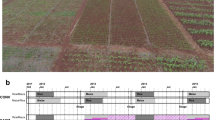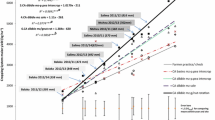Abstract
Striga hermonthica is a major constraint to smallholder subsistence agriculture production in the sub-Saharan African region. Low soil fertility and overall environmental degradation has contributed to the build-up of the parasitic weed infestation. Improved cropping systems have to be introduced to address the interrelated problems of S. hermonthica and soil fertility decline. Thus, the effects of improved fallow with leguminous shrub Sesbania sesban on maize yields and levels of S. hermonthica infestation on farm land in the bimodal highlands of western Kenya were investigated. The experimental treatments were arranged in a phased entry, and randomized complete block scheme were six months Sesbania fallow, 18 months Sesbania fallow, six months natural fallow consisting of regrowth of natural vegetation without cultivation, 18 months natural fallow, continuous maize cropping without fertilizer application, and continuous maize cropping with P and N fertilization. Results show that Sesbania fallows significantly (p<0.05) increase maize yield relative to continuous unfertilized maize. S. hermonthica plant populations decrease in continuous maize between the first season (mean = 428 000 ± 63 000 ha−1) and second season (mean=51 000 ± 15 000 ha−1), presumably in response to good weed management. S. hermonthica seed populations in the soil decrease throughout the duration of the experiment in the continuous maize treatments. Short-duration Sesbania fallows can provide modest yield improvements relative to continuous unfertilized maize, but short-duration weedy fallows are ineffective. Continuous maize cultivation with good weed control may provide more effective S. hermonthica control than fallowing.
Similar content being viewed by others
References
Andrianjaka Z, Bally R, Lepage M, Thioulouse J, Comte G, Kisa M, Duponnois R. 2007. Biological control of striga hermonthica by cubitermes termite mound powder amendment in sorghum culture. Applied Soil Ecology, 37: 175–183.
Buresh RJ, A. SP, Calhoun F. 1997. Replenishing soil fertility in Africa. SSSA special publication number 51. 251 pp. Soil Science Society of America inc., Madison, USA.
Crookston RK, Kurle JE, Copeland PJ, Ford JH, Lueschen WE. 1991. Rotational cropping sequence affects yield of corn and soybean. Agronomy Journal, 83: 108–113.
Gacheru E, Rao MR. 2005. The potential of planted shrub fallows to combat striga infestation on maize. International Journal of Pest Management, 51: 91–100.
Gallagher RS, M. FEC, McCallie EL. 1999. Weed management through short term improved fallows in tropical agro-ecosystems. Agroforestry System, 47: 197–221.
Gomez KA, Gomez AA. 1976. Statistical procedures for agricultural research, New York: John Whiley & Sons, 680 pp.
Hartemink AE, Buresh RJ, Van Bodegom PM, Braun AR, Jama B, Janssen BH. 2000. Inorganic nitrogen dynamics in fallows and maize on an oxisol and alfisol in the highlands of Kenya. Geoderma, 98: 11–33.
Hassan R, Ransom JK, Ojiem J. 1995. The spatial distribution and farmers strategies to control striga in maize: Survey results from Kenya. In: maize research for stress environments. Proceedings of the Eastern and Southern Africa regional maize Conference, 4; Harare, Zimbabwe; 28 march–1 april 1994.
Jama B, Buresh RJ, Ndufa JK, Shepherd KD. 1998a. Vertical distribution of roots and soil nitrate: Tree species and phosphorus effects. Soil Sci Soc Am J, 62: 280–286.
Jama B, Buresh RJ, Place FM. 1998b. Sesbania tree fallows on phosphorus-deficient sites: Maize yield and financial benefit. Agronomy Journal, 90: 717–726.
Kiwia A, Imo M, Jama B, Okalebo JR. 2009. Coppicing improved fallows are profitable for maize production in striga infested soils of Western Kenya. Agroforestry Systems, 76: 455–465.
Kwesiga F, Coe R. 1994. The effect of short rotation sesbania sesban planted fallows on maize yield. Forest Ecology and Management, 64: 199–208.
Kwesiga FR, Franzel S, Place F, Phiri D, Simwanza CP. 1999. Sesbania sesban improved fallows in eastern zambia: Their inception, development and farmer enthusiasm. Agroforestry Systems, 47: 49–66.
Maroko JM, Buresh RJ, Smithson PC. 1998. Soil nitrogen availability as affected by fallow-maize systems on two soils in Kenya. Biol Fertil Soils, 26: 229–234.
Ndufa JK, Gathumbi SM, Kamiri HW, Giller KE, Cadisch G. 2009. Do Mixed-Species Legume Fallows Provide Long-Term Maize Yield Benefit Compared with Monoculture Legume Fallows? Agronomy Journal, 101: 1352–1362.
Ndung’u D, Odhiambo GD, Ransom JK. 1993. Methodology for quantifying striga seed numbers in soils of East Africa. African crop science conference proceeedings, Kampala, Uganda vol. 1 pp. 220–221.
Niang A, Gathumbi S, Amadalo B. 1996. The potential of short-duration improved fallow for crop productivity enhancement in the highlands of Western Kenya. East African Agricultural and Forest Journal, 62: 103–114.
Nyamadzawo G, Nyamugafata P, Chikowo R, Giller K. 2008. Residual effects of fallows on selected soil hydraulic properties in a kaolinitic soil subjected to conventional tillage (CT) and no tillage (NT). Agroforestry Systems, 72: 161–168.
Odhiambo GD. 1998. Studies on witchweed [striga hermontica (del.) benth]seed longevity and maize[zea mays l.] productivity under different management systems in Kenya. University of Reading, School of Plant Sciences, Department of agricultural botany. Thesis.
Oswald A, Ransom JK. 2001. Striga control and improved farm productivity using crop rotation. Crop Protection, 20: 113–120.
Pieterse AH, Verkleij JAC. 1991. Effect of soil conditions on striga development: A review. In: J. K. Ransom, l. J. Musselman, a. D. Worsham, and c. Parker (eds), Proceedings of the 5th international symposium on parasitic weeds, pp. 329–339. Cimmyt, june 1991, Nairobi, Kenya.
Pisanelli A, Poole J, Franzel S. 2008. The adoption of improved tree fallows in Western Kenya: farmer practices, knowledge and perception. Forests, Trees and Livelihoods, 18: 233–252
Ransom JK, Odhiambo GD. 1994. Long term effects of fertility and handweeding on striga in maize. In biology and management of orobanche. Proceedings of the third international workshop on orobanche and related striga research. Eds. Pieterse AH, Verkleij JAC and Borg SJ. Pp 513–519. Royal tropical institute, Amsterdam.
Samake O, Stomph TJ, Kropff MJ, Smaling EMA. 2006. Integrated pearl millet management in the sahel: Effects of legume rotation and fallow management on productivity and striga hermonthica infestation. Plant and Soil, 286: 245–257.
Scholes JD, Malcolm CP. 2008. Striga infestation of cereal crops - an unsolved problem in resource limited agriculture. Current Opinion in Plant Biology, 11: 180–186.
Shepherd KD, Walsh MG. 2002. Development of reflectance spectral libraries for characterization of soil properties. Soil Sci Soc Am J, 66: 988–998.
Sileshi G, Akinnifesi FK, Ajayi OC, Place F. 2008. Meta-analysis of maize yield response to planted fallow and green manure legumes in sub-Saharan Africa. Plant and Soil, 307: 1–19.
Smith MC, Webb M. 1996. Estimation of the seedbank of striga spp (scrophulariaceae) in Malian fields and the implications for a model of biocontrol of striga hermonthica. Weed Research, 36: 85–92.
Stahl L, Nyberg G, Hogberg P, Buresh RJ. 2002. Effects of planted tree fallows on soil nitrogen dynamics, above-ground and root biomass, n-2-fixation and subsequent maize crop productivity in Kenya. Plant and Soil, 243: 103–117.
Swinkels RA, Franzel S, Shepherd KD, Ohlsson E, Ndufa JK. 1997. The economics of short rotation improved fallows: Evidence from areas of high population density in western kenya. Agricultural Systems, 55: 99–121.
van Ast A, Bastiaans L, Katile S. 2005. Cultural control measures to diminish sorghum yield loss and parasite success under striga hermonthica infestations. Crop Protection, 24: 1023–1034.
van Delft GJ, Graves JD, Fitter AH, Pruiksma MA. 1997. Spatial distribution and population dynamics of striga hermonthica seeds in naturally infested farm soils. Plant and Soil, 195: 1–15.
van Delft GJ, Graves JD, Fitter AH, Van Ast A. 2000. Striga seed avoidance by deep planting and no-tillage in sorghum and maize. International Journal of Pest Management, 46: 251–256.
van Lauwe B, Diels J, Sanginga N, Merckx R. 2002. Integrated plant nutrient management in sub-saharian Africa: From concept to practice. tWallingford, CAB International, Cambridge University Press, pp. 352.
Worsham AD, Egley GH. 1990. Physiology of witchweed seed dormancy and germination. In: Sand, P.F., Eplee, R.E., Westbrooks, R.G. (Eds.), Witchweed Research and Control in the United States. Weed Science Society of America, No 5, USA, pp. 11–26.
Author information
Authors and Affiliations
Corresponding author
Additional information
Foundation project: This work was supported by Swedish International Development Cooperation Agency (Sida)
The online version is available at http://www.springerlink.com
Rights and permissions
About this article
Cite this article
Sjögren, H., Shepherd, K.D. & Karlsson, A. Effects of improved fallow with Sesbania sesban on maize productivity and Striga hermonthica infestation in Western Kenya. Journal of Forestry Research 21, 379–386 (2010). https://doi.org/10.1007/s11676-010-0085-0
Received:
Accepted:
Published:
Issue Date:
DOI: https://doi.org/10.1007/s11676-010-0085-0




